Monitoring of Composite Structures for Re-Usable Space Applications Using FBGs: The Influence of Low Earth Orbit Conditions
Abstract
1. Introduction
2. LEO Conditions
- MAIT (manufacturing, assembly, inspection, and testing) phase;
- storage, transportation, and handling;
- in-service phase.
3. Materials and Methods
3.1. FBG Working Principle and the Use of Capillaries
3.2. Coupon Geometry
3.3. TVac Conditioning
3.4. Visual Inspection
3.5. Tensile Testing
3.6. Compression Testing
3.7. Inter Laminar Shear Strength (ILSS) Testing
4. Results and Discussion
4.1. Functionality Testing of Embedded FBGs Subjected to TVac Conditong
4.2. Mechanical Strength Testing of CFRP Coupons with Embedded OF after TVac Conditiong
4.2.1. Visual Inspection
4.2.2. Tensile Test
4.2.3. Compression Test
4.2.4. ILLS Test
5. Conclusions
Author Contributions
Funding
Institutional Review Board Statement
Informed Consent Statement
Data Availability Statement
Conflicts of Interest
Appendix A. A Complete Overview of the Visual Inspection Results
Appendix A.1. Tensile Test Coupons
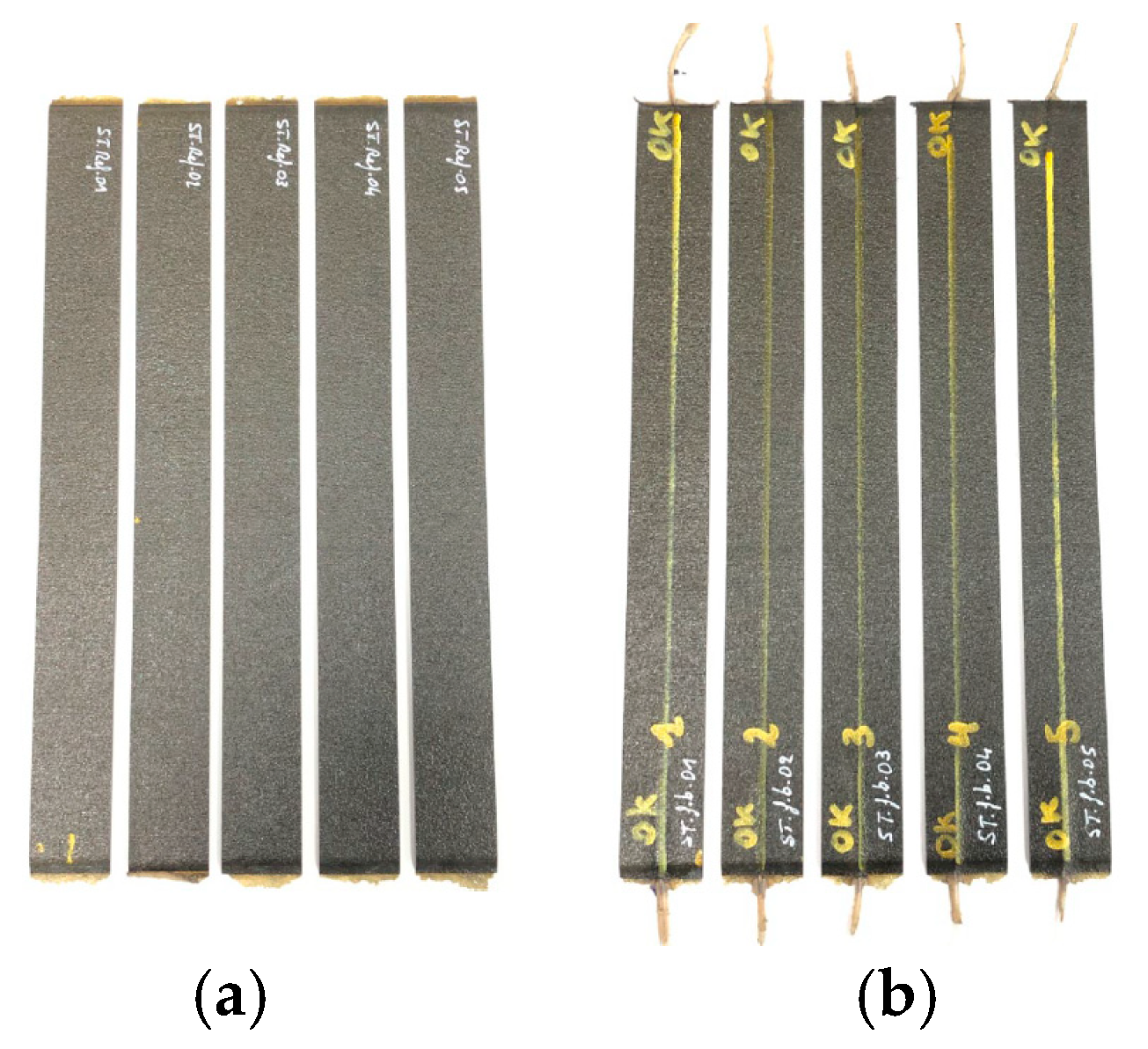
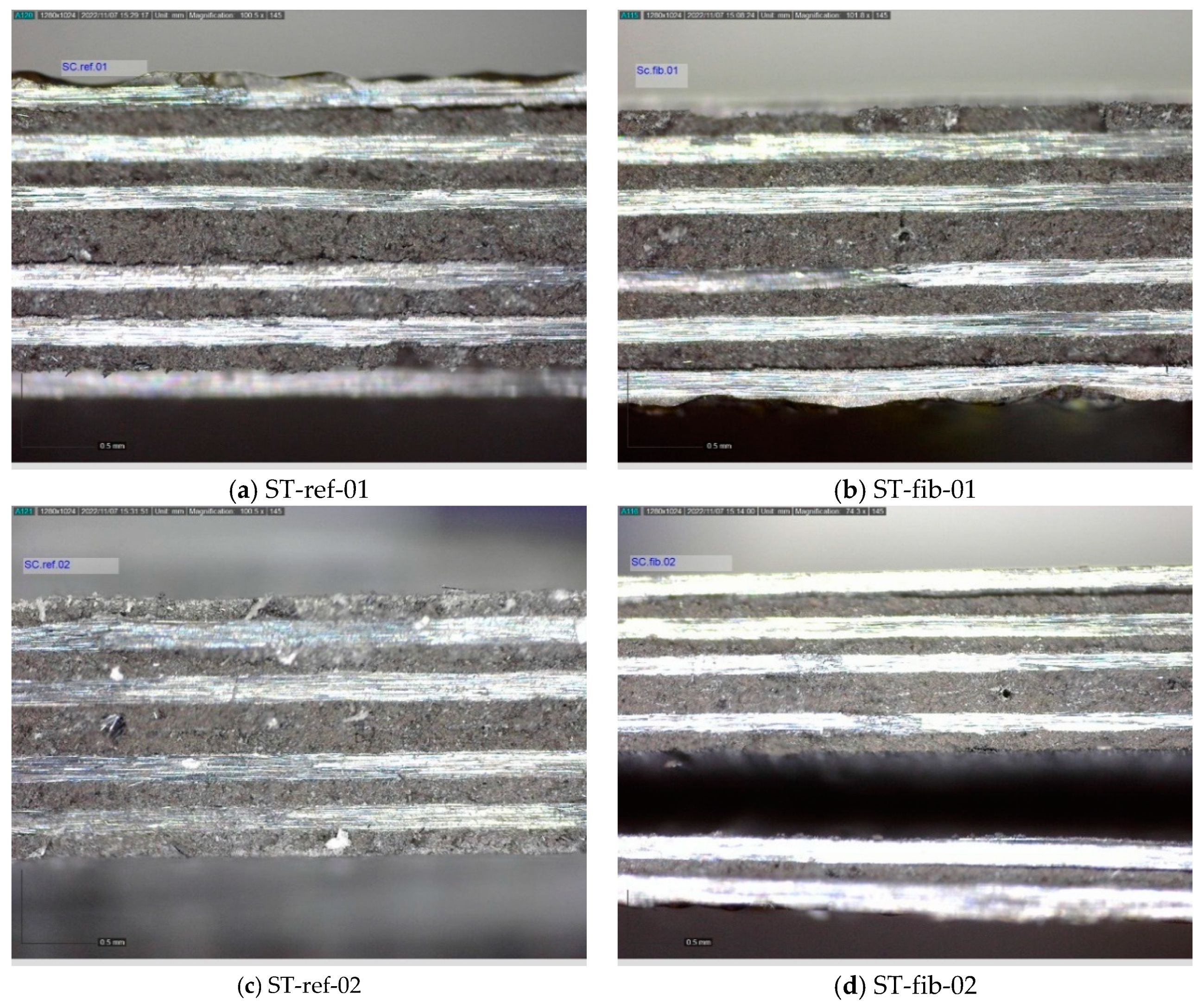
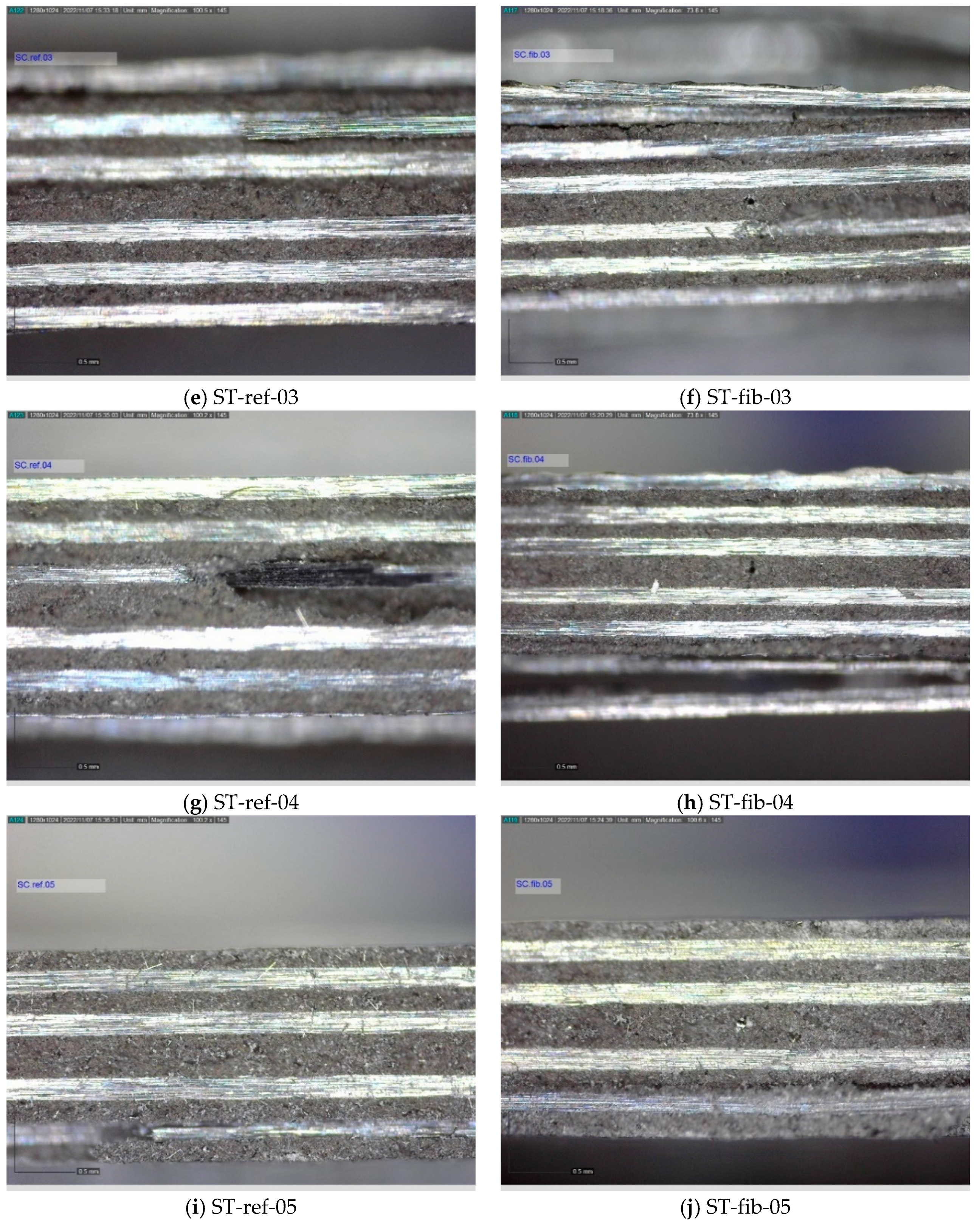
Appendix A.2. Compression Test Coupons
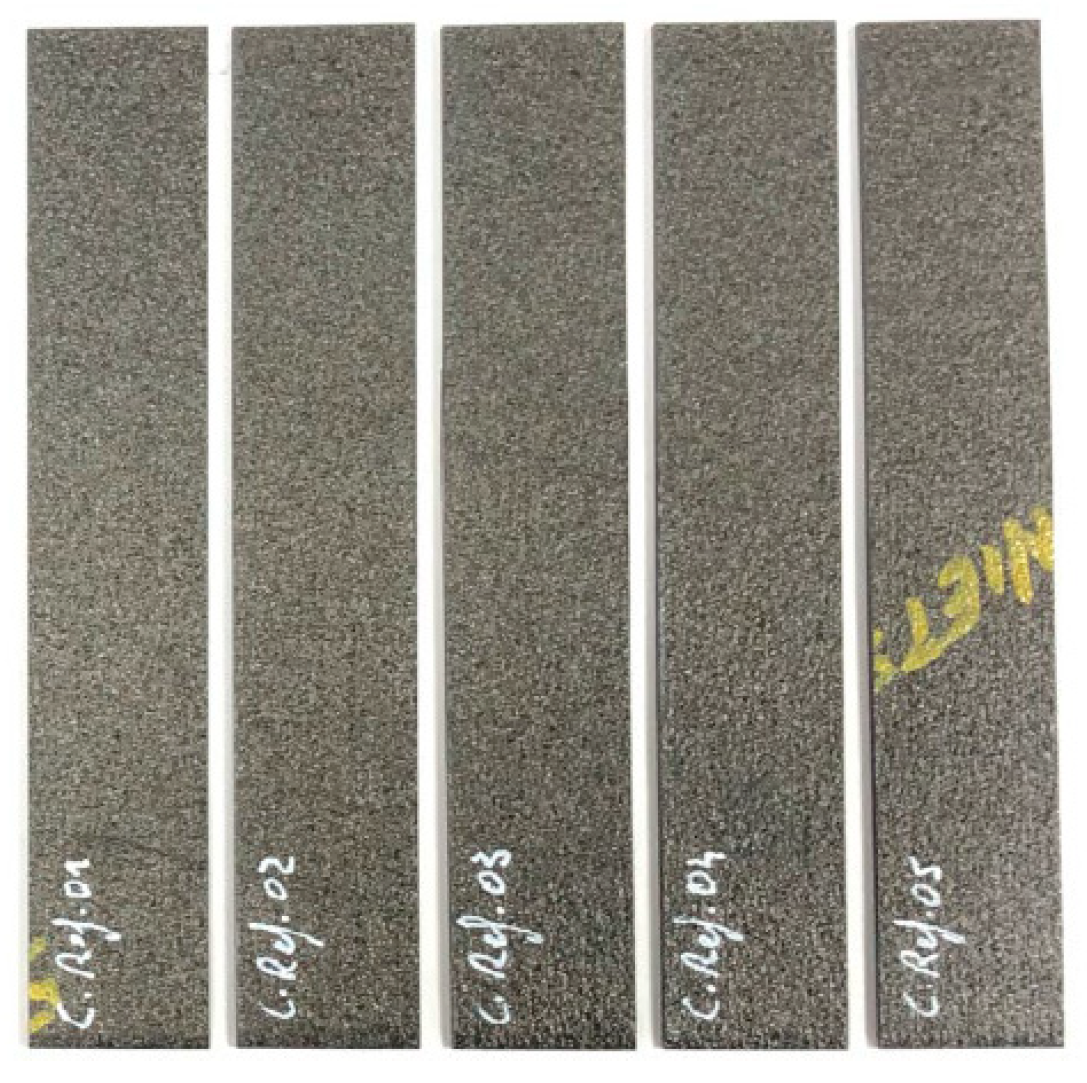
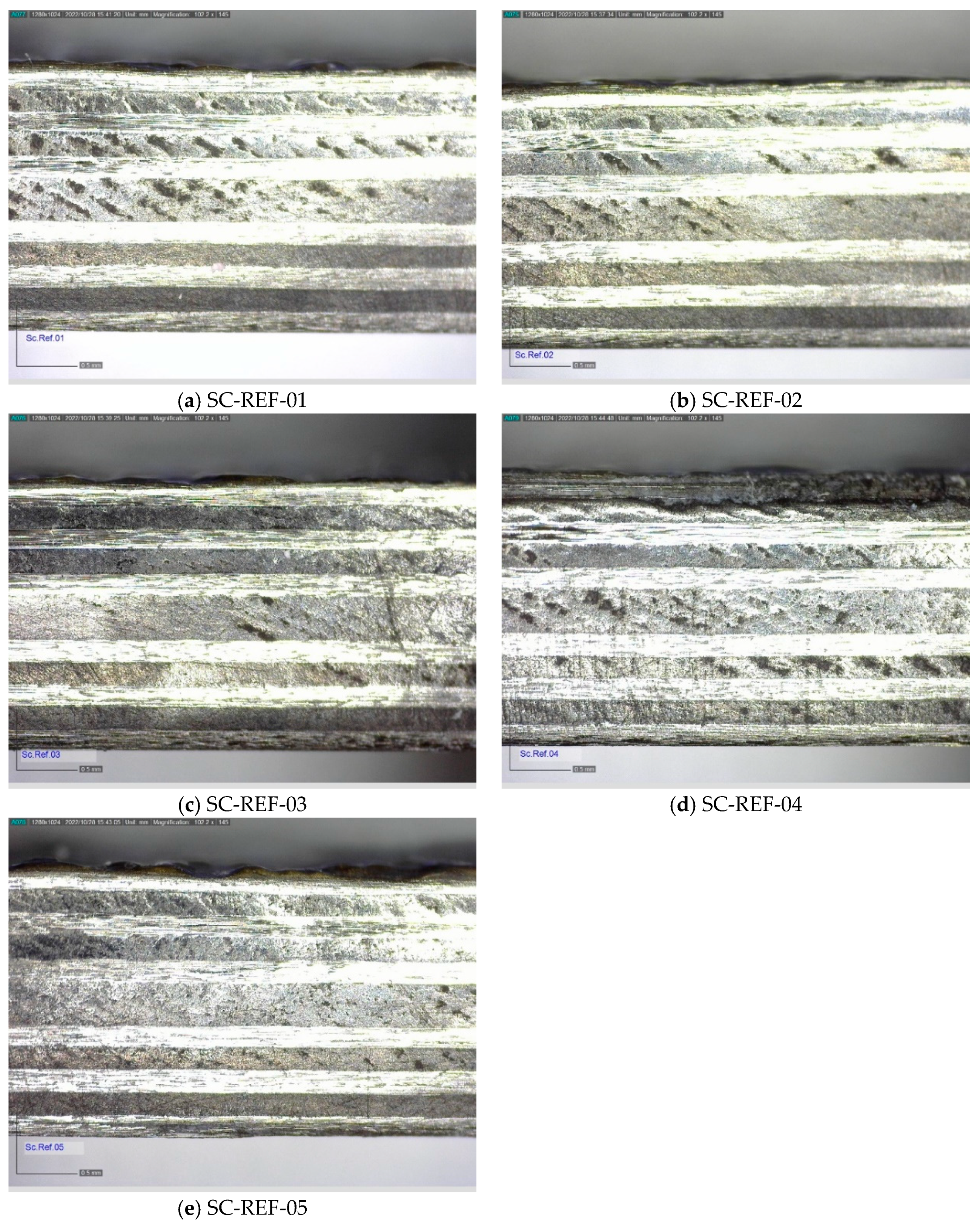

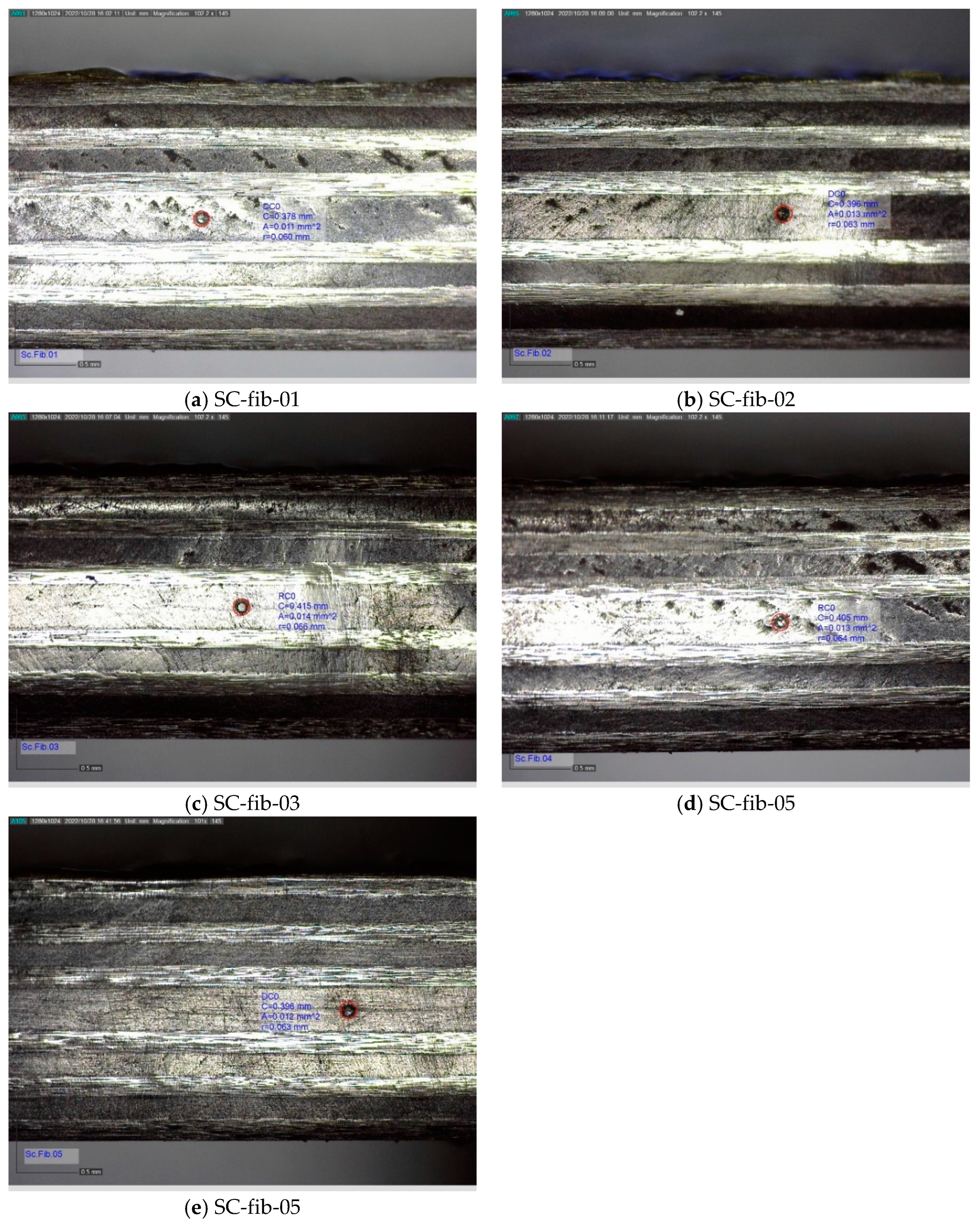
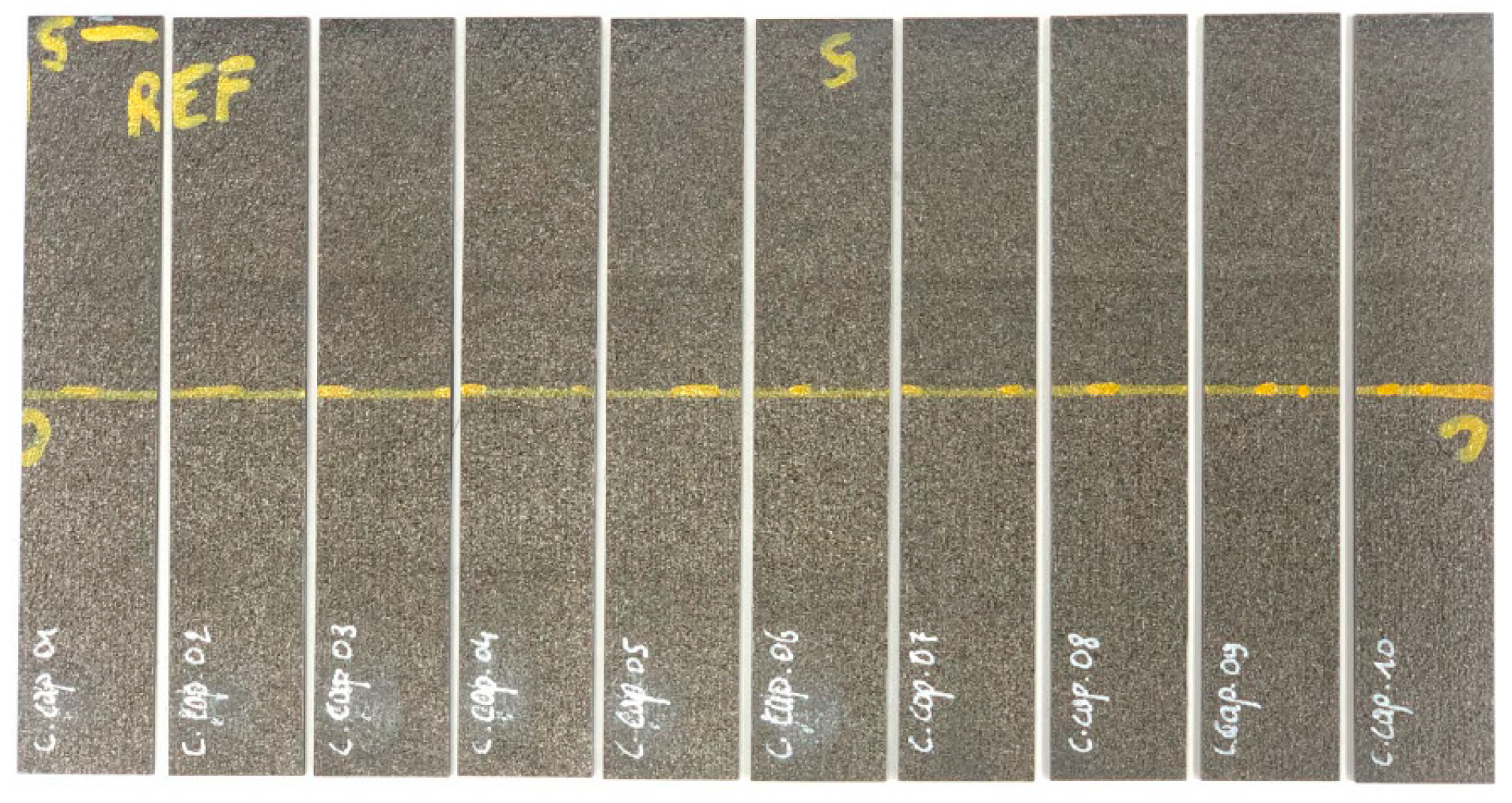
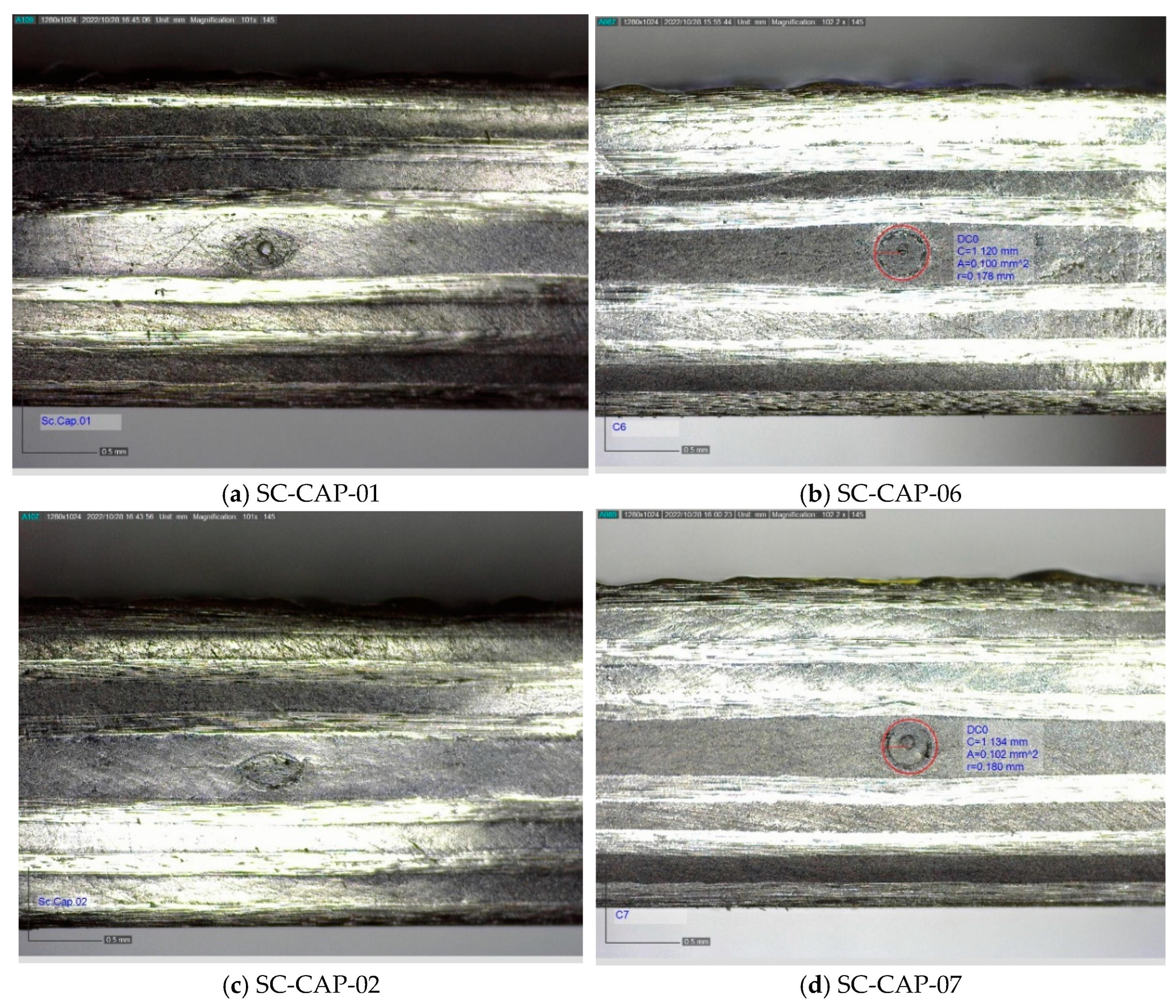

Appendix A.3. ILSS Test Coupoins



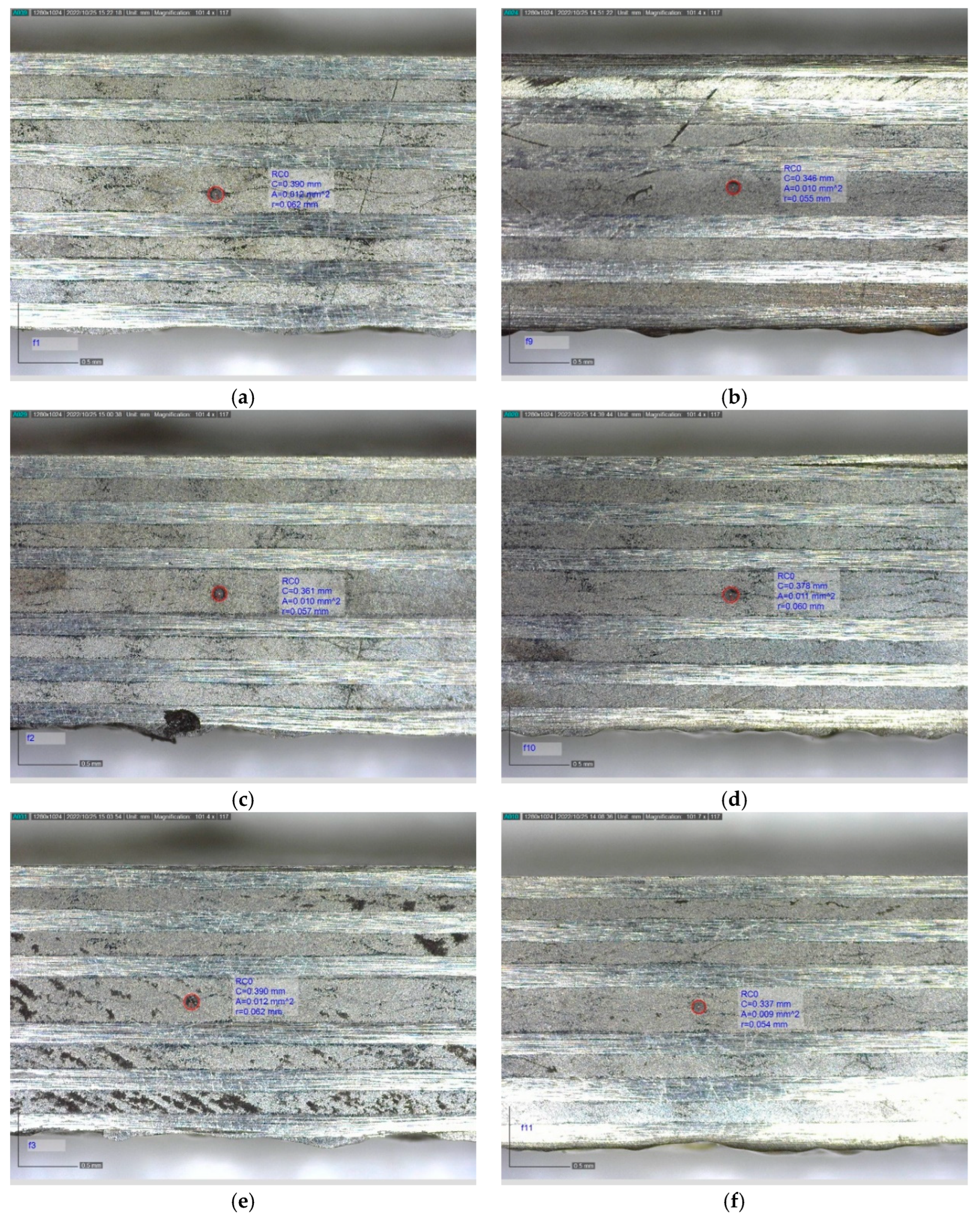
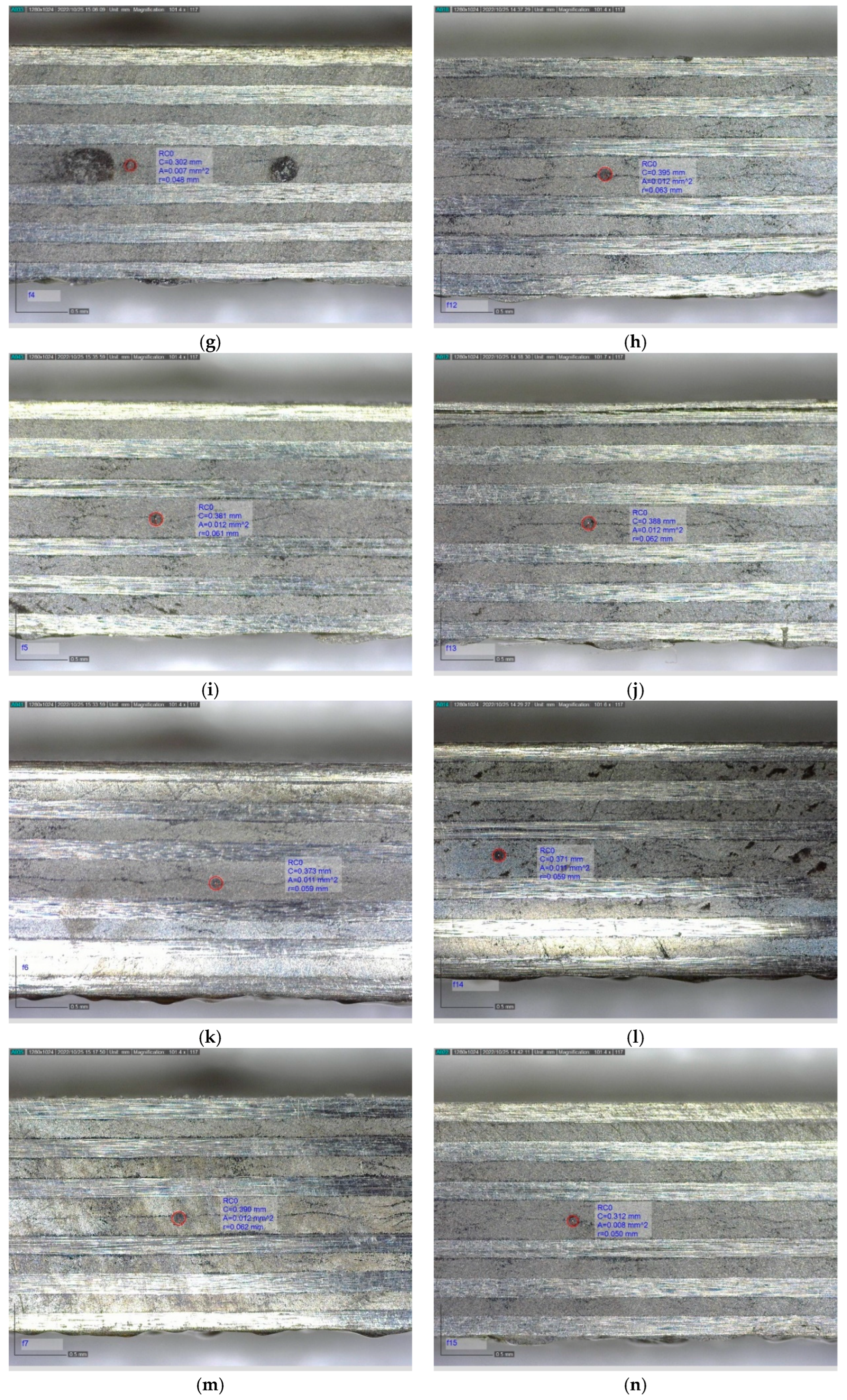
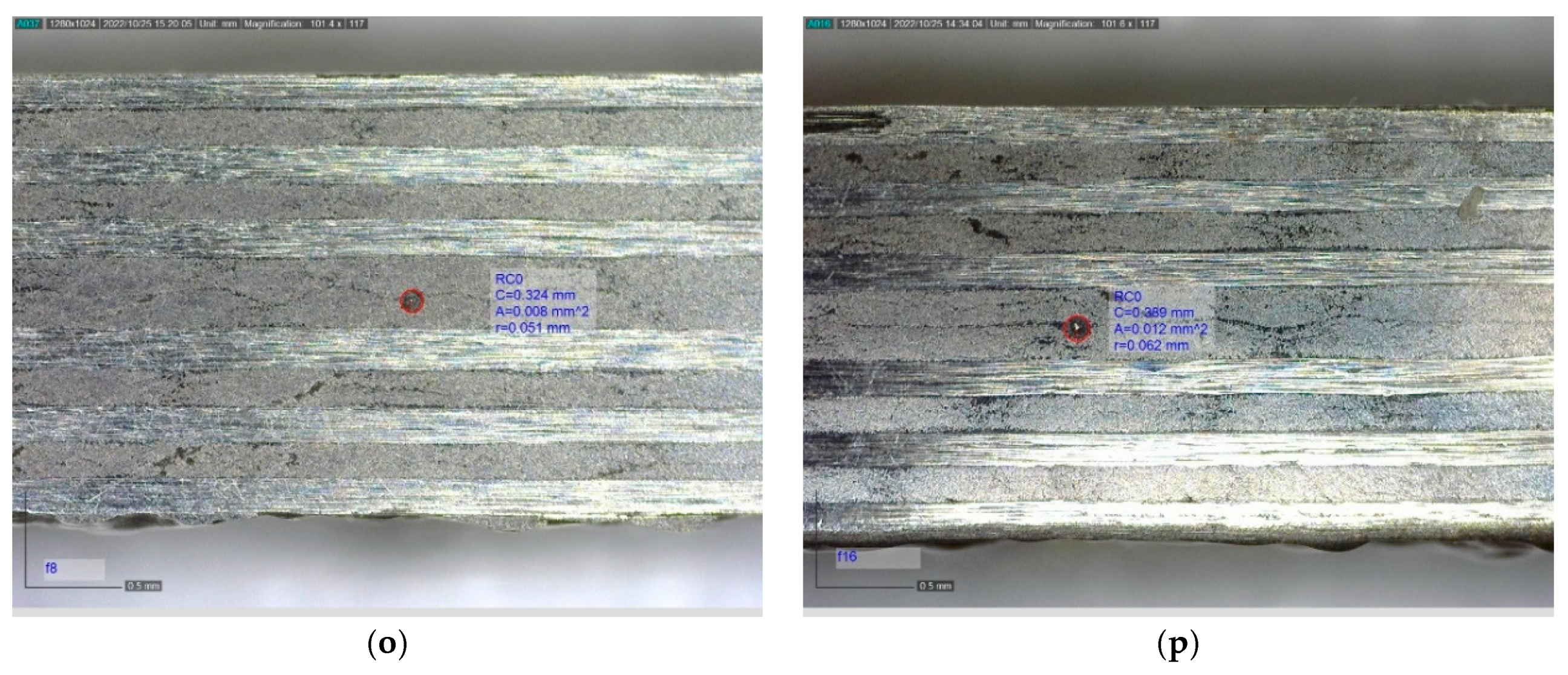



Appendix B. All Test Data
Appendix B.1. Tensile Test Data
| Coupon ID | TVac | OF/ No OF | Ultimate Strain Surface-Mounted Ref Sensor [%] | Ultimate Strain Embedded [%] | Ultimate Stress [MPa] | Correlation Embedded Sensor/Surface-Mounted Sensor | R2 | Stifness Ecomp [GPa] | Broken Mid-Section/Tab Section |
|---|---|---|---|---|---|---|---|---|---|
| ST-Ref-01 | Yes | No | 1.474 | - | 1046 | - | - | 72.2 | Mid-section |
| ST-Ref-02 | Yes | No | 1.413 | - | 977 | - | - | 70.4 | Tab section |
| ST-Ref-03 | Yes | No | 1.398 | - | 980 | - | - | 72.4 | Mid-section |
| ST-Ref-04 | Yes | No | 1.432 | - | 970 | - | - | 71.4 | Mid-section |
| ST-Ref-05 | Yes | No | 1.321 | - | 921 | - | - | 71.5 | Tab section |
| AVERAGE | 1.408 | - | 979 | - | - | 71.58 | |||
| STD | 0.050 | - | 40 | 0.71 | |||||
| CV | 3.6% | - | 4.1% | 1.0% | |||||
| Coupon ID | TVac | OF/ No OF | Ultimate Strain Surface-Mounted Ref Sensor [%] | Ultimate Strain Embedded [%] | Ultimate Stress [MPa] | Correlation Embedded Sensor/Surface-Mounted Sensor | R² | Stifness Ecomp [GPa] | Broken Mid-Section/Tab Section |
|---|---|---|---|---|---|---|---|---|---|
| ST-fib-01 | Yes | Yes | 1.549 | 1.541 | 1091 | 0.994 | 1 | 71.5 | Mid-section |
| ST-fib-02 | Yes | Yes | 1.253 | 1.264 | 885 | 1.008 | 1 | 72.2 | Mid-section |
| ST-fib-03 | Yes | Yes | 1.473 | 1.470 | 1034 | 0.996 | 1 | 71.4 | Mid-section |
| ST-fib-04 | Yes | Yes | 1.402 | 1.406 | 984 | 1.001 | 1 | 71.2 | Mid-section |
| ST-fib-05 | Yes | Yes | 1.347 | 1.332 | 903 | 1.016 | 1 | 70.0 | Mid-section |
| AVERAGE | 1.405 | 1.403 | 979 | 1.003 | 1 | 71.26 | |||
| STD | 0.102 | 0.098 | 78 | 0.008 | 0.71 | ||||
| CV | 7.2% | 7.0% | 7.9% | 0.8% | 1.0% | ||||
Appendix B.2. Compression Test Data
| Coupon ID | TVac | OF/ No OF/CAP | Ultimate Strain Surface-Mounted Ref Sensor [%] | Ultimate Stress [MPa] | Stiffness Echord [GPa] | Broken Mid-Section/Tab Section |
|---|---|---|---|---|---|---|
| SC-Ref-01 | Yes | No OF | −1.195 | 601 | −55.7 | Mid-section |
| SC-Ref-02 | Yes | No OF | −1.380 | 701 | −58.8 | Mid-section |
| SC-Ref-03 | Yes | No OF | −1.285 | 665 | −58.1 | Mid-section |
| SC-Ref-04 | Yes | No OF | −1.374 | 694 | −56.9 | Mid-section |
| SC-Ref-05 | Yes | No OF | −1.802 | 657 | −43.0 | Mid-section |
| AVERAGE | −1.3085 | 663.6 | −57.4 | |||
| STD | 0.076 | 35.460 | 1.2 | |||
| CV | −5.8% | 5.3% | −2.1% | |||
| Coupon ID | TVAC | OF/ No OF/CAP | Ultimate Strain Surface-Mounted Ref Sensor [%] | Ultimate Stress [MPa] | Stifness Echord [GPa] | Broken Mid-Section/Tab Section |
|---|---|---|---|---|---|---|
| SC-fib-01 | Yes | OF | - | 638 | −53 | Mid-section |
| SC-fib-02 | Yes | OF | −1.224 | 675 | −56.4 | Mid-section |
| SC-fib-03 | Yes | OF | −1.166 | 650 | −60.5 | Mid-section |
| SC-fib-04 | Yes | OF | −1.203 | 697 | −57.5 | Mid-section |
| SC-fib-05 | Yes | OF | −1.303 | 678 | −53.9 | Mid-section |
| AVERAGE | −1.224 | 667.6 | −56.3 | |||
| STD | 0.050 | 21.03901 | 2.7 | |||
| CV | 4.1% | 3.2% | −4.8% | |||
| Coupon ID | TVac | OF/ No OF/CAP | Ultimate Strain Surface-Mounted Ref Sensor [%] | Ultimate Stress [MPa] | Stifness Echord [GPa] | Broken Mid-Section/Tab Section |
|---|---|---|---|---|---|---|
| SC-CAP-01 | No | CAP | −1.231 | 683 | −60.1 | Mid-section |
| SC-CAP-02 | No | CAP | −1.272 | 692 | −56.8 | Mid-section |
| SC-CAP-03 | No | CAP | −1.299 | 677 | −56.3 | Mid-section |
| SC-CAP-04 | No | CAP | −1.172 | 578 | −59.5 | Mid-section |
| SC-CAP-05 | No | CAP | −1.293 | 672 | −54.4 | Mid-section |
| AVERAGE | −1.253 | 660 | −57.4 | |||
| STD | 0.047 | 47 | 2.1 | |||
| CV | 3.8% | 7.1% | 3.7% | |||
| Coupon ID | TVAC | OF/ No OF/CAP | Ultimate Strain Surface-Mounted Ref Sensor [%] | Ultimate Stress [MPa] | Stifness Echord [GPa] | Broken Mid-Section/Tab Section |
|---|---|---|---|---|---|---|
| SC-CAP-06 | Yes | CAP | −1.245 | 657 | −59.5 | Mid-section |
| SC-CAP-07 | Yes | CAP | −1.313 | 624 | −54.3 | Mid-section |
| SC-CAP-08 | Yes | CAP | −1.254 | 632 | −57.6 | Mid-section |
| SC-CAP-09 | Yes | CAP | −1.154 | 614 | −57.4 | Mid-section |
| SC-CAP-10 | Yes | CAP | −1.218 | 629 | −60.5 | Mid-section |
| AVERAGE | −1.237 | 631 | −57.9 | |||
| STD | 0.052 | 14.519 | 2.1 | |||
| CV | −4.2% | 2.3% | 3.7% | |||
Appendix B.3. ILSS Test
| Coupon ID | TVac | OF/ No OF/CAP | Interlaminar Shear Strength [MPa] | Broken at Neutral Axis? Yes/No |
|---|---|---|---|---|
| ILSS-REF-01 | Yes | No OF | 93.9 | Yes |
| ILSS-REF-02 | Yes | No OF | 72.7 | Yes |
| ILSS-REF-03 | Yes | No OF | 94.4 | Yes |
| ILSS-REF-04 | Yes | No OF | 91.7 | Yes |
| ILSS-REF-05 | Yes | No OF | 94.1 | Yes |
| AVERAGE | 89.4 | |||
| STD | 8.4 | |||
| CV | 9.4% | |||
| ILSS-REF-06 | No | No OF | 89.8 | Yes |
| ILSS-REF-07 | No | No OF | 76.7 | Yes |
| ILSS-REF-08 | No | No OF | 93.7 | Yes |
| AVERAGE | 86.7 | |||
| STD | 7.3 | |||
| CV | 8.4 | |||
| Coupon ID | TVac | OF/ No OF/CAP | Interlaminar Shear Strength [MPa] | Broken at Neutral Axis? Yes/No |
|---|---|---|---|---|
| ILSS-FIB-01 | Yes | OF | 79.64 | Yes |
| ILSS-FIB-02 | Yes | OF | 84.98 | Yes |
| ILSS-FIB-03 | Yes | OF | 73.15 | Yes |
| ILSS-FIB-04 | Yes | OF | 80.71 | Yes |
| ILSS-FIB-05 | Yes | OF | 86.89 | Yes |
| AVERAGE | 81.1 | |||
| STD | 4.8 | |||
| CV | 5.9% | |||
| ILSS-FIB-06 | No | OF | 91.01 | Yes |
| ILSS-FIB-07 | No | OF | 73.57 | Yes |
| ILSS-FIB-08 | No | OF | 88.97 | Yes |
| ILSS-FIB-09 | No | OF | 71.05 | Yes |
| ILSS-FIB-10 | No | OF | 85.82 | Yes |
| AVERAGE | 82.1 | |||
| STD | 8.2 | |||
| CV | 10.0% | |||
| Coupon ID | TVac | OF/ No OF/CAP | Interlaminar Shear Strength [MPa] | Broken at Neutral Axis? Yes/No |
|---|---|---|---|---|
| ILSS-CAP-01 | Yes | CAP | 73.2 | Yes |
| ILSS-CAP-02 | Yes | CAP | 79.8 | Yes |
| ILSS-CAP-03 | Yes | CAP | 86.1 | Yes |
| ILSS-CAP-04 | Yes | CAP | 77.4 | Yes |
| ILSS-CAP-05 | Yes | CAP | 87.5 | Yes |
| AVERAGE | 80.8 | |||
| STD | 5.4 | |||
| CV | 6.6% | |||
| ILSS-CAP-06 | No | CAP | 71.6 | Yes |
| ILSS-CAP-07 | No | CAP | 83.0 | Yes |
| ILSS-CAP-08 | No | CAP | 82.3 | Yes |
| AVERAGE | 79.0 | |||
| STD | 5.2 | |||
| CV | 6.6% | |||
References
- Aloisi, S.; Galietti, U.; Pappalettere, C. Strain Measurement in Composite Materials Using Embedded Strain Gauges. Key Eng. Mater. 1997, 144, 251–260. [Google Scholar] [CrossRef]
- Ju, M.; Dou, Z.; Li, J.W.; Qiu, X.; Shen, B.; Zhang, D.; Yao, F.-Z.; Wen, G.; Ke, W. Piezoelectric Materials and Sensors for Structural Health Monitoring: Fundamental Aspects, Current Status, and Future Perspectives. Sensors 2023, 23, 543. [Google Scholar] [CrossRef] [PubMed]
- Giurgiutiu, V. Structural Health Monitoring with Piezoelectric Wafer Active Sensors—Predictive Modeling and Simulation. Incas Bull. 2010, 2, 31–44. [Google Scholar] [CrossRef]
- Voet, E.; Luyckx, G.; De Waele, W.; Degrieck, J. Multi-Axial Strain Transfer from Laminated Cfrp Composites to Embedded Bragg Sensor: Ii. Experimental Validation. Smart Mater. Struct. 2010, 19, 105018. [Google Scholar] [CrossRef]
- Missinne, J.; Teigell Benéitez, N.; Mattelin, M.A.; Lamberti, A.; Luyckx, G.; Van Paepegem, W.; Van Steenberge, G. Bragg-Grating-Based Photonic Strain and Temperature Sensor Foils Realized Using Imprinting and Operating at Very near Infrared Wavelengths. Sensors 2018, 18, 2717. [Google Scholar] [CrossRef] [PubMed]
- Missinne, J.; Teigell Benéitez, N.; Lamberti, A.; Chiesura, G.; Luyckx, G.; Mattelin, M.A.; Van Paepegem, W.; Van Steenberge, G. Thin and Flexible Polymer Photonic Sensor Foils for Monitoring Composite Structures. Adv. Eng. Mater. 2018, 20, 1701127. [Google Scholar] [CrossRef]
- Majumder, M.; Gangopadhyay, T.K.; Chakraborty, A.K.; Dasgupta, K.; Bhattacharya, D.K. Fibre Bragg Gratings in Structural Health Monitoring—Present Status and Applications. Sens. Actuators A Phys. 2008, 147, 150–164. [Google Scholar] [CrossRef]
- McKenzie, I.; Ibrahim, S.; Haddad, E.; Abad, S.; Hurni, A.; Cheng, L.K. Fiber Optic Sensing in Spacecraft Engineering: An Historical Perspective from the European Space Agency. Rev. Front. Phys. 2021, 9, 719441. [Google Scholar] [CrossRef]
- Olivier, P.; Mulle, M.; Paris, C.; Collombet, F. Carbon/Polymeric Composites Autoclave Cure Monitoring with Optical Fiber Bragg Grating (Fbg) Sensors. In Wiley Encyclopedia of Composites; Wiley Publications: Hoboken, NJ, USA, 2012; pp. 1–11. Available online: https://onlinelibrary.wiley.com/doi/abs/10.1002/9781118097298.weoc026 (accessed on 8 July 2023).
- Jaiswal, P.R.; Kumar, R.I.; Juwet, T.; Luyckx, G.; Verhaeghe, C.; De Waele, W. Experimental Deformation Analysis of an Adhesively Bonded Multi-Material Joint for Marine Applications. Strain 2023, 59, e12433. [Google Scholar] [CrossRef]
- Akay, E.; Yilmaz, C.; Kocaman, E.S.; Turkmen, H.S.; Yildiz, M. Monitoring Poisson’s Ratio Degradation of Frp Composites under Fatigue Loading Using Biaxially Embedded Fbg Sensors. Materials 2016, 9, 781. [Google Scholar] [CrossRef]
- Szebényi, G.; Blößl, Y.; Hegedüs, G.; Tábi, T.; Czigany, T.; Schledjewski, R. Fatigue Monitoring of Flax Fibre Reinforced Epoxy Composites Using Integrated Fibre-Optical Fbg Sensors. Compos. Sci. Technol. 2020, 199, 108317. [Google Scholar] [CrossRef]
- Tsuda, H.; Toyama, N.; Urabe, K.; Takatsubo, J. Impact Damage Detection in Cfrp Using Fiber Bragg Gratings. Smart Mater. Struct. 2004, 13, 719–724. [Google Scholar] [CrossRef]
- Lamberti, A.; Luyckx, G.; Van Paepegem, W.; Rezayat, A.; Vanlanduit, S. Detection, Localization and Quantification of Impact Events on a Stiffened Composite Panel with Embedded Fiber Bragg Grating Sensor Networks. Sensors 2017, 17, 743. [Google Scholar] [CrossRef] [PubMed]
- Du, L.; Jiang, W.; Luo, Z.; Song, H.; Yang, L.; Li, H. Multi Fbg Sensor-Based Impact Localization with a Hybrid Correlation Interpolation Method. Meas. Sci. Technol. 2022, 33, 075002. [Google Scholar] [CrossRef]
- Wang, H.P.; Wu, Y.B.; Chen, C.; Zhang, H.Y.; Jiang, H.; Zhang, X.M.; Xu, X.Y. Dynamic Response of Cfrp Reinforced Steel Beams Subjected to Impact Action Based on Fbg Sensing Technology. Sensors 2022, 22, 6377. [Google Scholar] [CrossRef] [PubMed]
- Takeda, N.; Okabe, Y.; Kuwahara, J.; Kojima, S.; Ogisu, T. Development of Smart Composite Structures with Small-Diameter Fiber Bragg Grating Sensors for Damage Detection: Quantitative Evaluation of Delamination Length in Cfrp Laminates Using Lamb Wave Sensing. Compos. Sci. Technol. 2005, 65, 2575–2587. [Google Scholar] [CrossRef]
- Abbas, S.; Li, F.; Qiu, J. A Review on Shm Techniques and Current Challenges for Characteristic Investigation of Damage in Composite Material Components of Aviation Industry. ASTM Int. 2018, 7, 224–258. [Google Scholar] [CrossRef]
- Giurgiutiu, V. Structural Health Monitoring (Shm) of Aerospace Composites. In Polymer Composites in the Aerospace Industry, 2nd ed.; Irving, P., Soutis, C., Eds.; Woodhead Publishing: Shaston, UK, 2020; pp. 491–558. [Google Scholar]
- MPB Communications Inc. Available online: https://www.mpbcommunications.com (accessed on 10 November 2023).
- MDA. Available online: https://mda.space/en/ (accessed on 10 November 2023).
- Haddad, E.; Kruzelecky, R.V.; Mena, M.; Tagziria, K.; Ricci, F.; McKenzie, I.; Karafolas, N.; Hannoteau, F. Optical Fiber Sensors System on Proba-2 after 7 Years. In Proceedings of the SPIE, Biarritz, France, 25 September 2017. [Google Scholar] [CrossRef]
- Friebele, E.J.; Askins, C.G.; Bosse, A.B.; Kersey, A.D.; Patrick, H.J.; Pogue, W.R.; Putnam, M.A.; Simon, W.R.; Tasker, F.A.; Vincent, W.S. Optical Fiber Sensors for Spacecraft Applications. Smart Mater. Struct. 1999, 8, 813. [Google Scholar] [CrossRef]
- Kang, S.G.; Gang, D.H.; Kim, C.G.; Hong, C.S. Measurement of Cte Change in a Composite Laminate with Aging under Space Environment Using Fiber Optic Sensors. J. Korean Soc. Aeronaut. Space Sci. 2003, 31, 21–26. [Google Scholar] [CrossRef]
- Park, S.O.; Moon, J.B.; Lee, Y.G.; Kim, C.G.; Bhowmik, S. Usage of Fiber Bragg Grating Sensors in Low Earth Orbit Environment. In Proceedings of the SPIE, San Diego, CA, USA, 8 April 2008; Volume 6932. [Google Scholar] [CrossRef]
- Kim, H.I.; Yoon, J.S.; Kim, H.B.; Han, J.H. Measurement of the Thermal Expansion of Space Structures Using Fiber Bragg Grating Sensors and Displacement Measuring Interferometers. Meas. Sci. Technol. 2010, 21, 085704. [Google Scholar] [CrossRef]
- Rapp, S.; Baier, H. Integrated Fiber Optic Sensors for Hot Spot Detection and Temperature Field Reconstruction in Satellites. Smart Mater. Struct. 2010, 19, 075007. [Google Scholar] [CrossRef]
- Lee, D.C.; Lee, J.J.; Yun, S.J. The Mechanical Characteristics of Smart Composite Structures with Embedded Optical Fiber Sensors. Compos. Struct. 1995, 32, 39–50. [Google Scholar] [CrossRef]
- Hadzic, R.; John, S.; Herszberg, I. Structural Integrity Analysis of Embedded Optical Fibres in Composite Structures. Compos. Struct. 1999, 47, 759–765. [Google Scholar] [CrossRef]
- ASTM D3039/D3029M-17; Standard Test Method for Tensile Properties of Polymer Matrix Composite Materials. ASTM International: West Conshohocken, PA, USA, 2017. [CrossRef]
- Surgeon, M.; Wevers, M. Static and Dynamic Testing of a Quasi-Isotropic Composite with Embedded Optical Fibres. Compos. Part A Appl. Sci. Manuf. 1999, 30, 317–324. [Google Scholar] [CrossRef]
- Mall, S.; Dosedel, S.B.; Holl, M.W. The Performance of Graphite—Epoxy Composite with Embedded Optical Fibers under Compression. Smart Mater. Struct. 1996, 5, 209. [Google Scholar] [CrossRef]
- Ling, H.Y.; Lau, K.T.; Lam, C.K. Effects of Embedded Optical Fibre on Mode II Fracture Behaviours of Woven Composite Laminates. Compos. Part B Eng. 2005, 36, 534–543. [Google Scholar] [CrossRef]
- Bowles, D.E. Effect of Microcracks on the Thermal Expansion of Composite Laminates. J. Compos. Mater. 1984, 18, 173–187. [Google Scholar] [CrossRef]
- Plante, J.; Lee, B. Environmental Conditions for Space Flight Hardware: A Survey; Online publication; NASA: Washington, DC, USA, 2005. Available online: https://ntrs.nasa.gov/citations/20060013394 (accessed on 10 May 2023).
- ASTM D3410/D3410M-16; Standard Test Method for Compressive Properties of Polymer Matrix Composite Materials with Unsupported Gage Section by Shear Loading. ASTM International: West Conshohocken, PA, USA, 2015. [CrossRef]
- NBN EN 2563:1997; Lucht-en Ruimtevaart—Met Koolstofvezel Versterkte Kunststoffen—Laminaten Met Vezels in één Enkele Richting—Bepaling van de Schijnbare Interlaminaire Afschuifsterkte. Bureau voor Normalisatis: Brussels, Belgium, 1997. Available online: https://app.nbn.be/data/r/platform/frontend/detail?p40_id=258468&p40_language_code=nl&p40_detail_id=106672&session=9370514703471 (accessed on 13 November 2023).
- Hill, K.O.; Meltz, G. Fiber Bragg Grating Technology Fundamentals and Overview. J. Light. Technol. 1997, 15, 1263–1276. [Google Scholar] [CrossRef]
- FBGS. Available online: https://fbgs.com/technology/fbg-principle/ (accessed on 10 November 2023).
- Available online: https://www.hexcel.com/user_area/content_media/raw/HexPly_8552_eu_DataSheet(1).pdf (accessed on 10 November 2023).
- Luyckx, G.; Voet, E.; Lammens, N.; Degrieck, J. Strain Measurements of Composite Laminates with Embedded Fibre Bragg Gratings: Criticism and Opportunities for Research. Sensors 2011, 11, 384–408. [Google Scholar] [CrossRef]


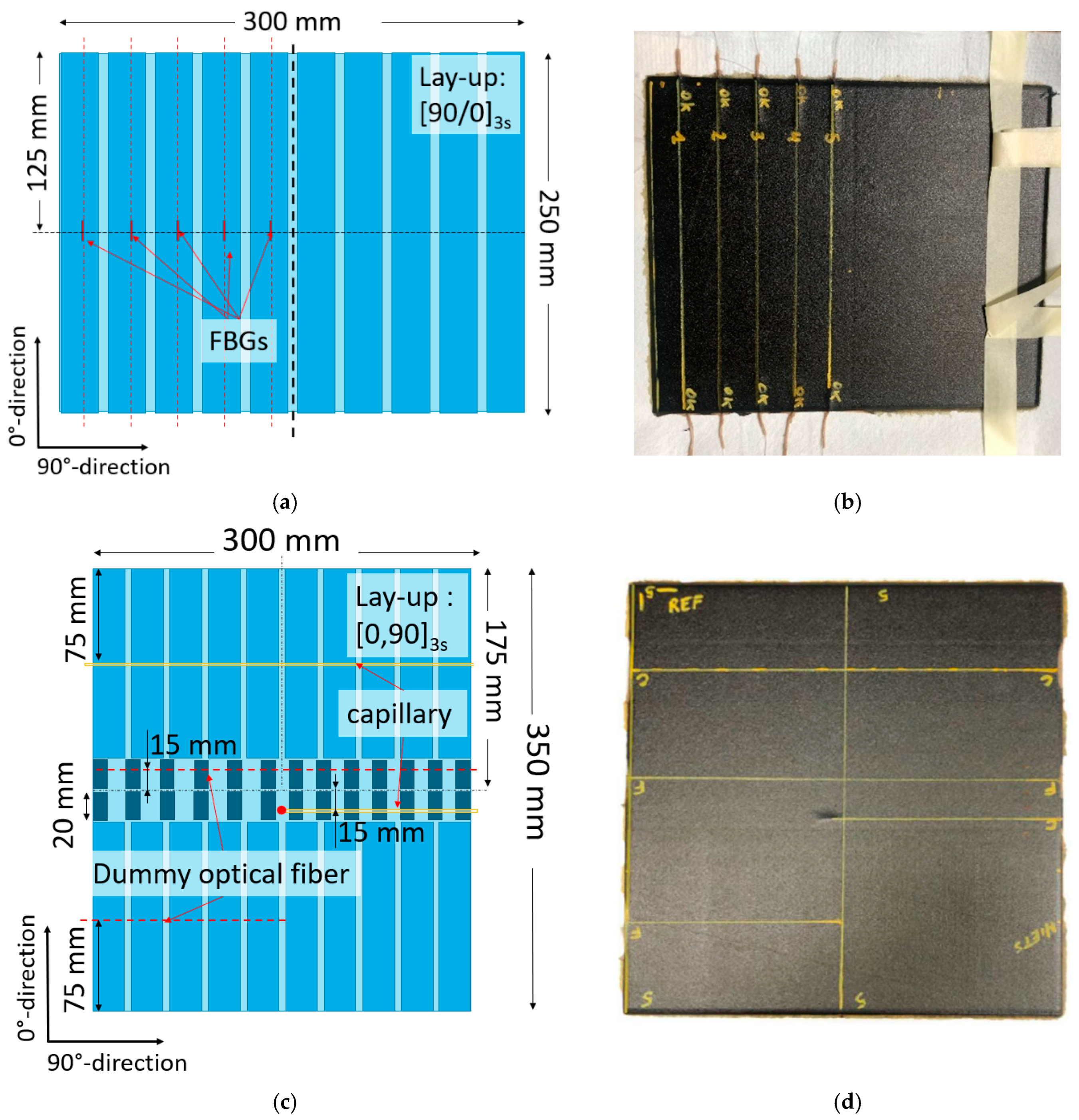



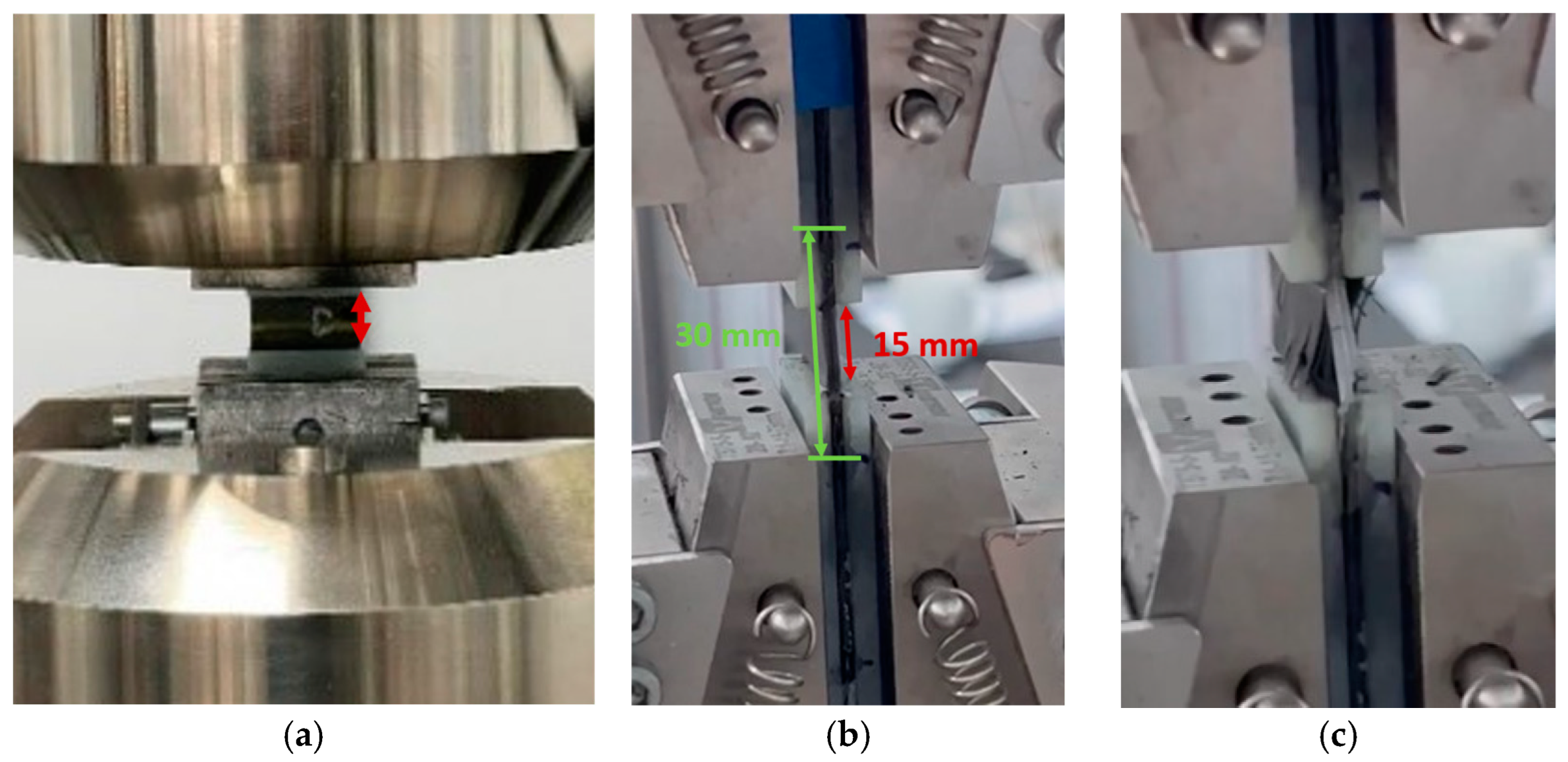
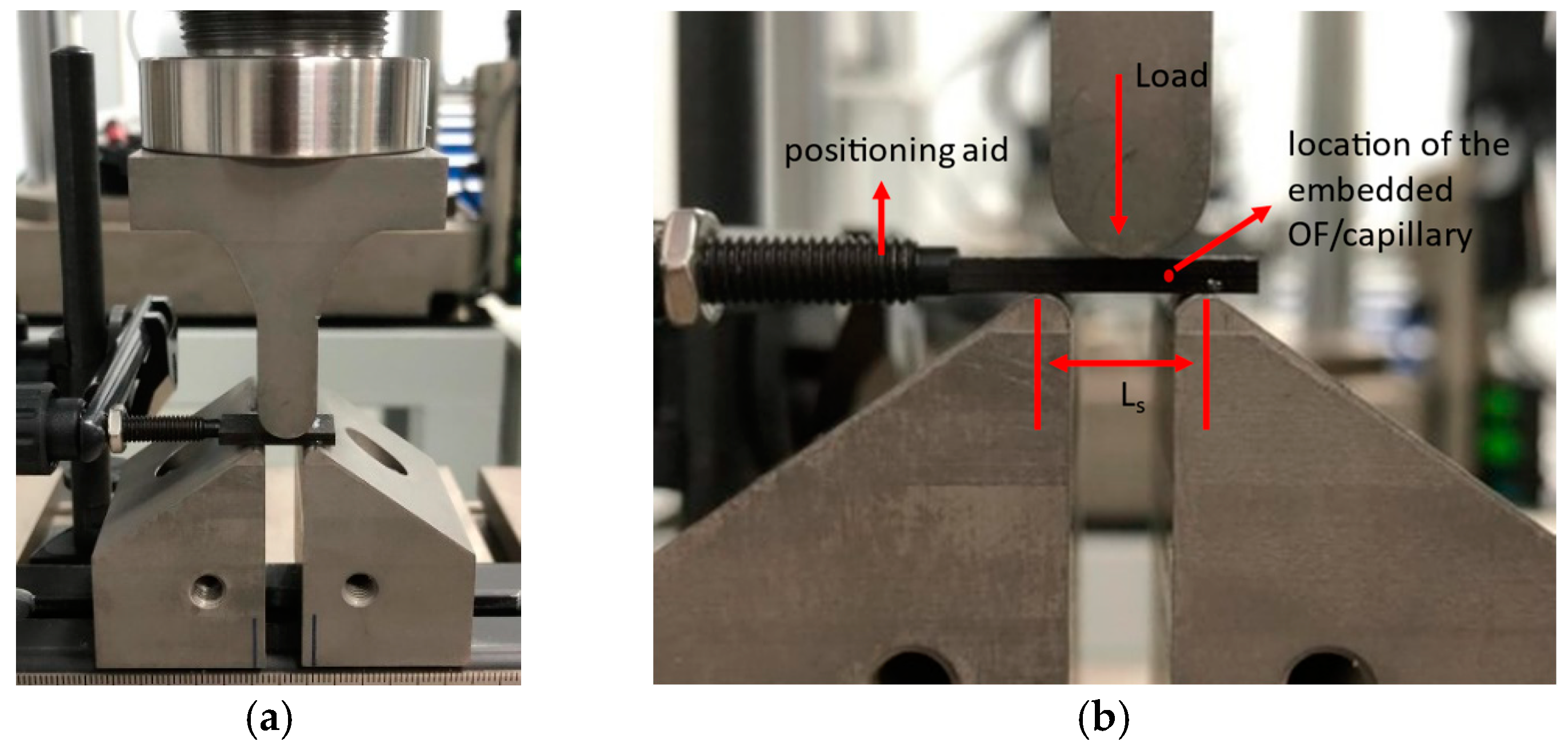

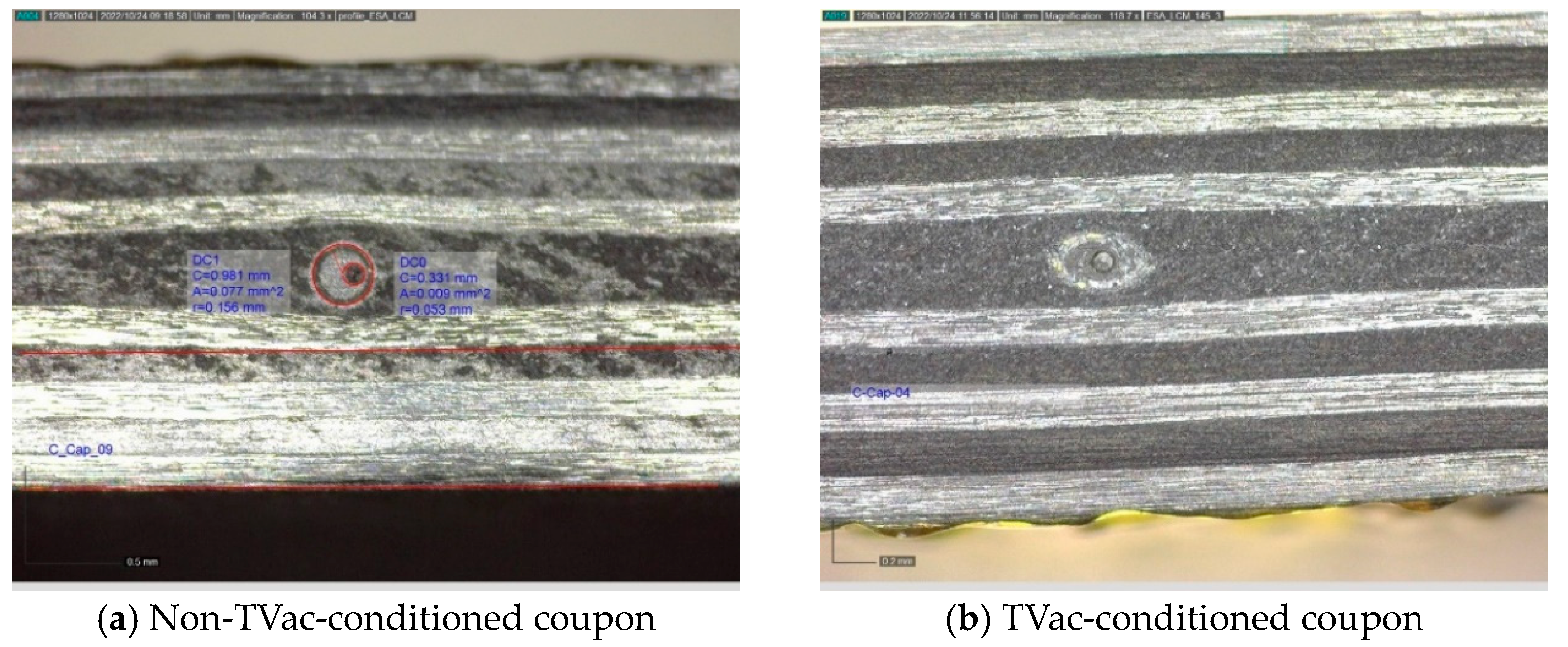
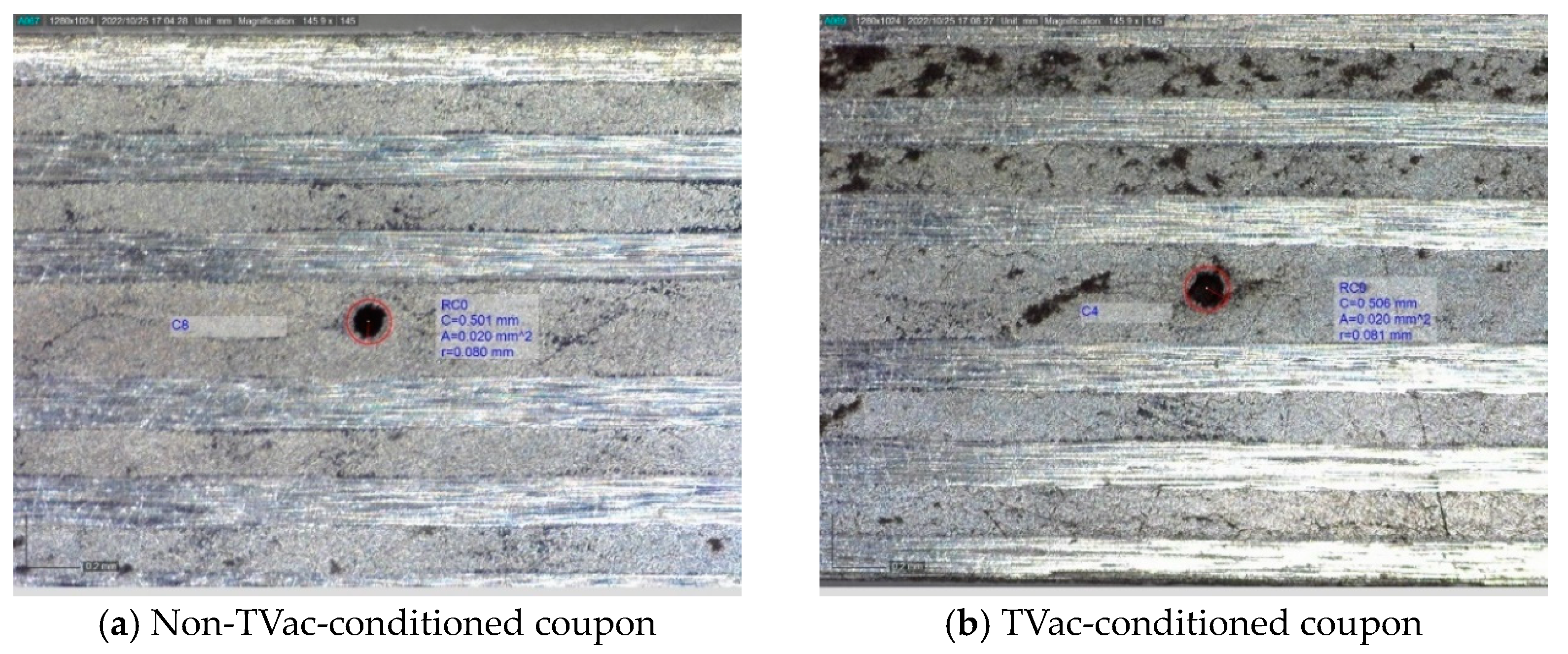

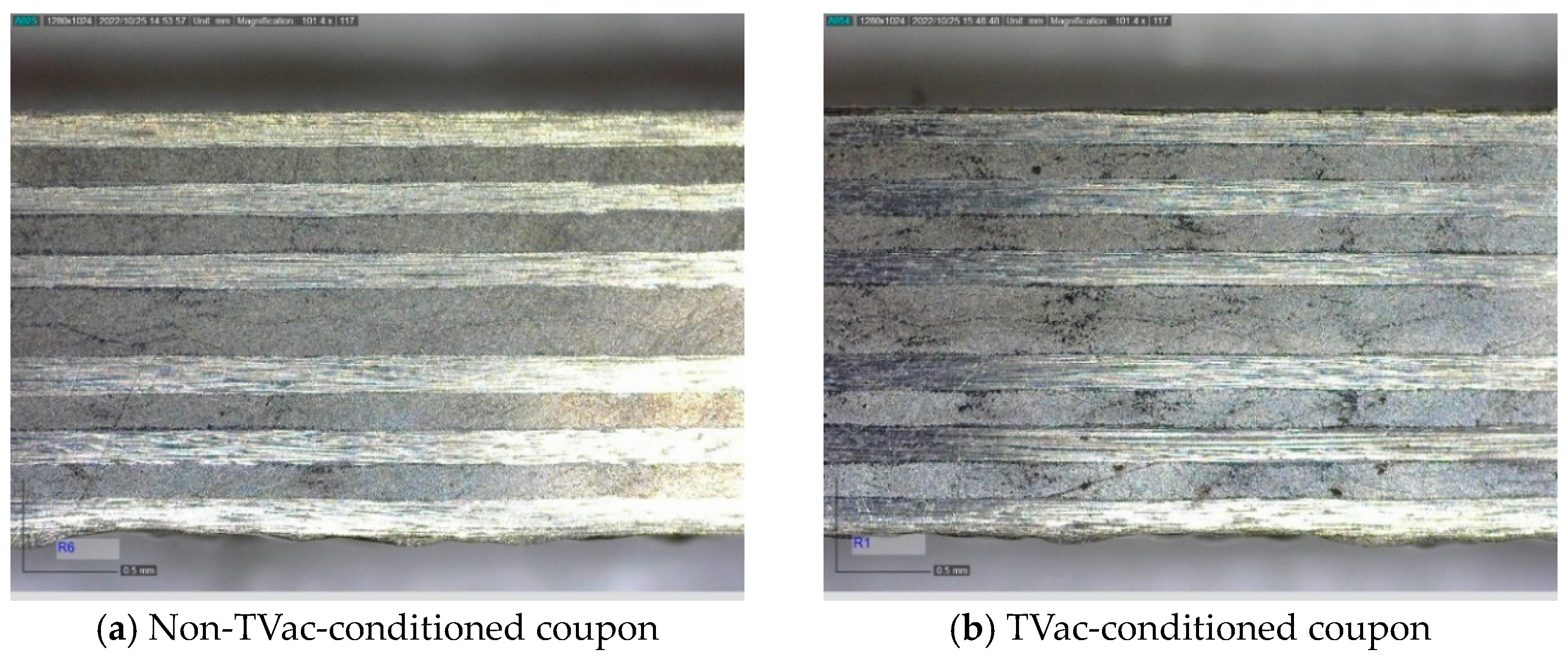
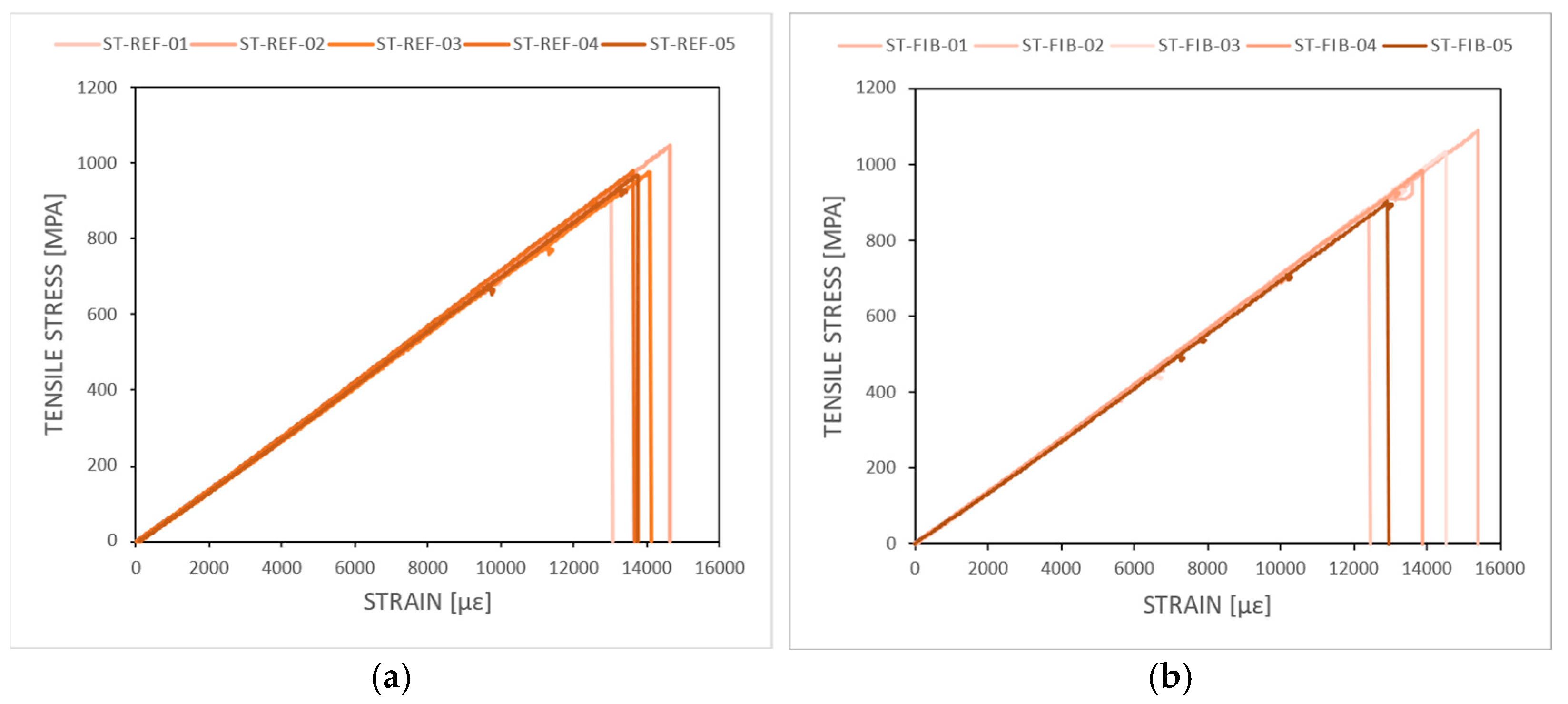
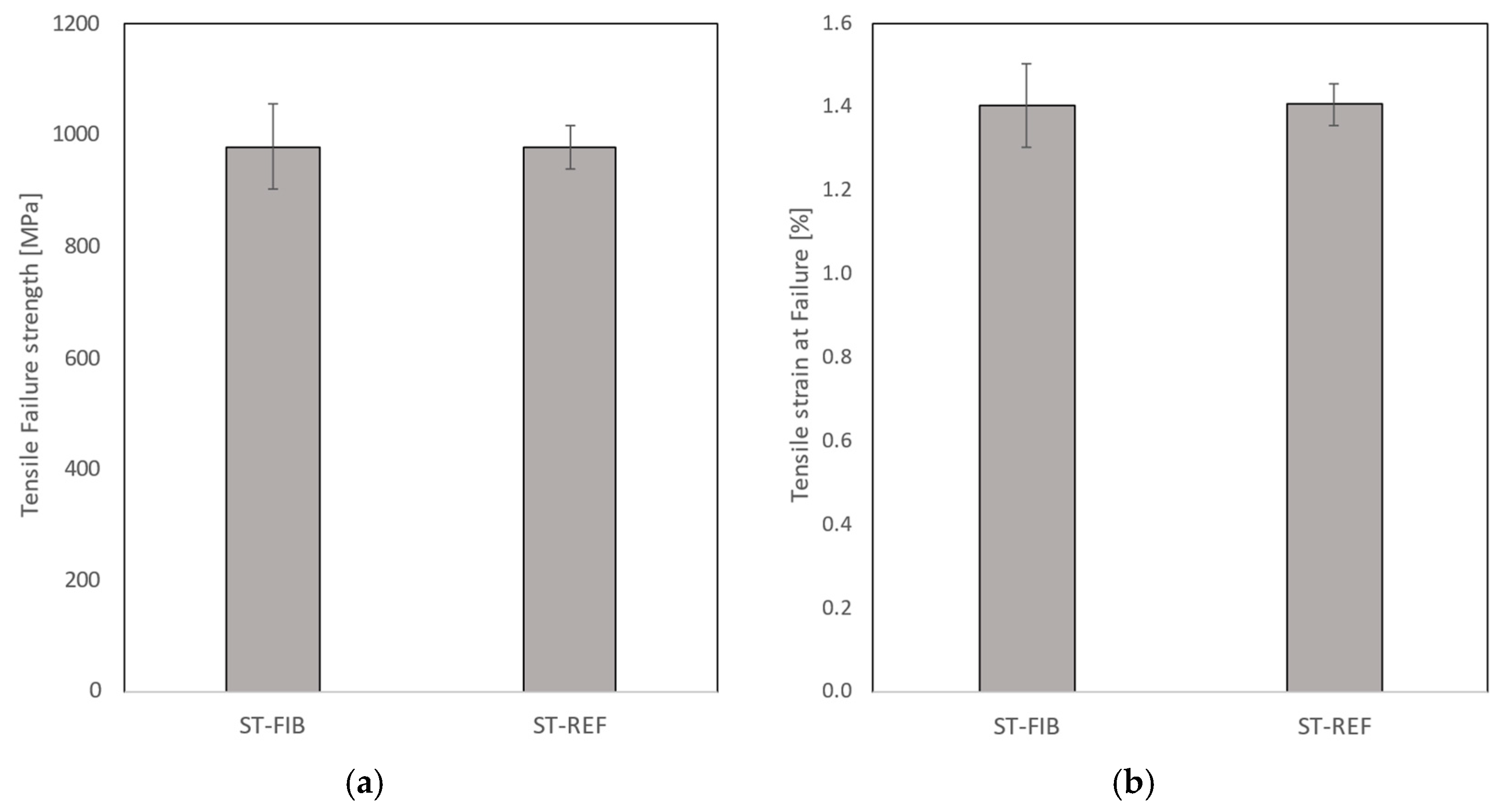


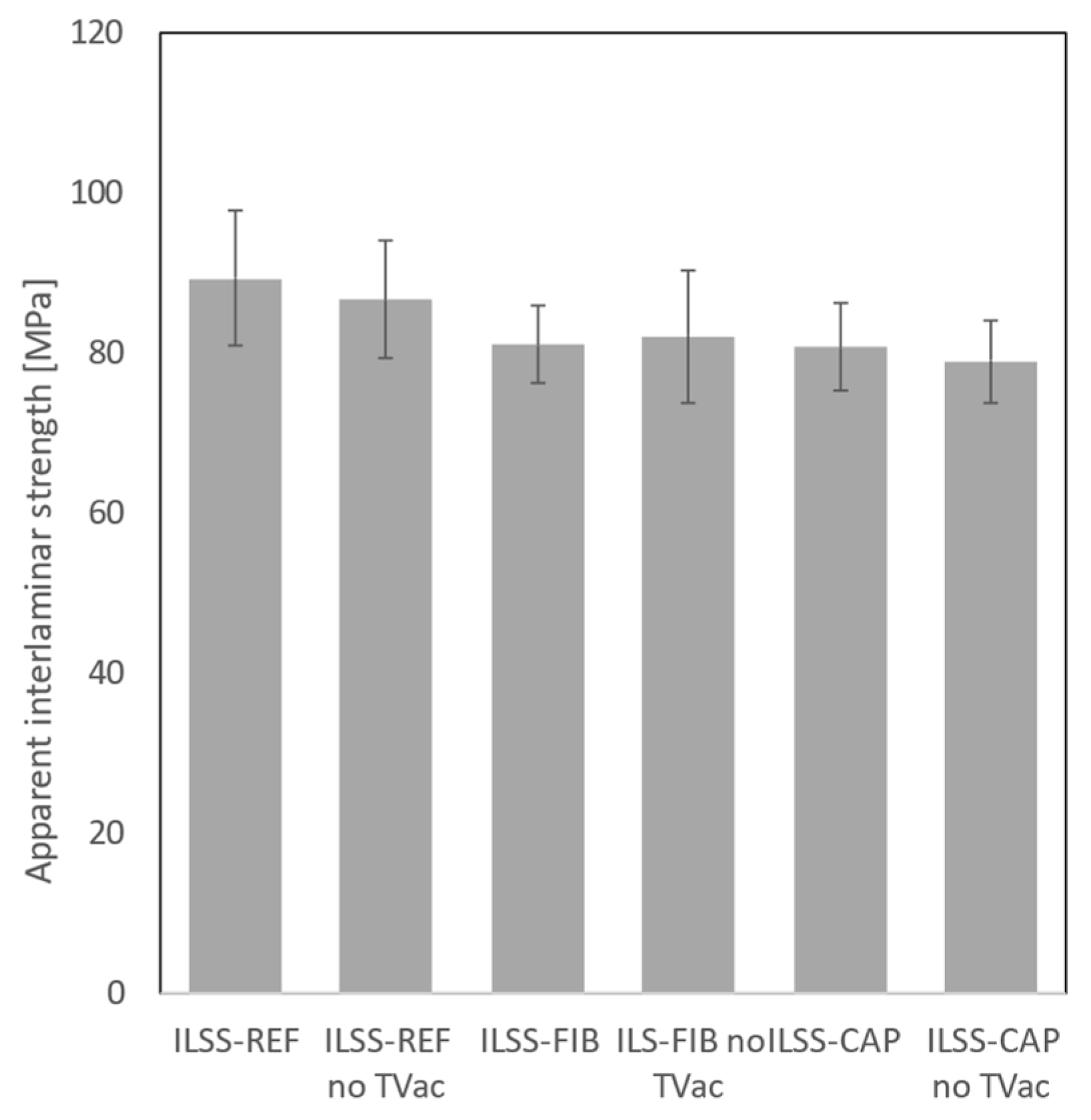
| Lay-Up | Width [mm] | Nominal Length [mm] | Thickness [mm] | |
|---|---|---|---|---|
| Tensile test | [90/0]3s | 25 | 250 | 2.5 |
| Compression test | [0/90]3s | 25 | 150 | 2.5 |
| ILSS test | [0/90]3s | 10 | 20 | 2.5 |
| TVac | No TVac | Total | |||||||
|---|---|---|---|---|---|---|---|---|---|
| REF | OF | CAP | Total | REF | OF | CAP | Total | ||
| Tensile test | 5 | 5 | - | 10 | - | - | - | 0 | 10 |
| Compression test | 5 | 5 | 5 | 15 | - | - | 5 | 5 | 20 |
| ILSS test | 5 | 5 | 5 | 15 | 3 | 5 | 3 | 11 | 26 |
| Coupon ID | Ultimate Strain Surface-Mounted Ref Sensor [%] | Ultimate Strain Embedded Sensor [%] | Correlation Embedded Sensor/Surface-Mounted Sensor |
|---|---|---|---|
| ST-fib-01 | 1.549 | 1.541 | 0.994 |
| ST-fib-02 | 1.253 | 1.264 | 1.008 |
| ST-fib-03 | 1.473 | 1.470 | 0.996 |
| ST-fib-04 | 1.402 | 1.406 | 1.001 |
| ST-fib-05 | 1.347 | 1.332 | 1.016 |
| Average | 1.405 | 1.403 | 1.003 |
| STD | 0.102 | 0.098 | 0.008 |
Disclaimer/Publisher’s Note: The statements, opinions and data contained in all publications are solely those of the individual author(s) and contributor(s) and not of MDPI and/or the editor(s). MDPI and/or the editor(s) disclaim responsibility for any injury to people or property resulting from any ideas, methods, instructions or products referred to in the content. |
© 2024 by the authors. Licensee MDPI, Basel, Switzerland. This article is an open access article distributed under the terms and conditions of the Creative Commons Attribution (CC BY) license (https://creativecommons.org/licenses/by/4.0/).
Share and Cite
Juwet, T.; Luyckx, G.; Lamberti, A.; Creemers, F.; Voet, E.; Missinne, J. Monitoring of Composite Structures for Re-Usable Space Applications Using FBGs: The Influence of Low Earth Orbit Conditions. Sensors 2024, 24, 306. https://doi.org/10.3390/s24010306
Juwet T, Luyckx G, Lamberti A, Creemers F, Voet E, Missinne J. Monitoring of Composite Structures for Re-Usable Space Applications Using FBGs: The Influence of Low Earth Orbit Conditions. Sensors. 2024; 24(1):306. https://doi.org/10.3390/s24010306
Chicago/Turabian StyleJuwet, Thibault, Geert Luyckx, Alfredo Lamberti, Frank Creemers, Eli Voet, and Jeroen Missinne. 2024. "Monitoring of Composite Structures for Re-Usable Space Applications Using FBGs: The Influence of Low Earth Orbit Conditions" Sensors 24, no. 1: 306. https://doi.org/10.3390/s24010306
APA StyleJuwet, T., Luyckx, G., Lamberti, A., Creemers, F., Voet, E., & Missinne, J. (2024). Monitoring of Composite Structures for Re-Usable Space Applications Using FBGs: The Influence of Low Earth Orbit Conditions. Sensors, 24(1), 306. https://doi.org/10.3390/s24010306








